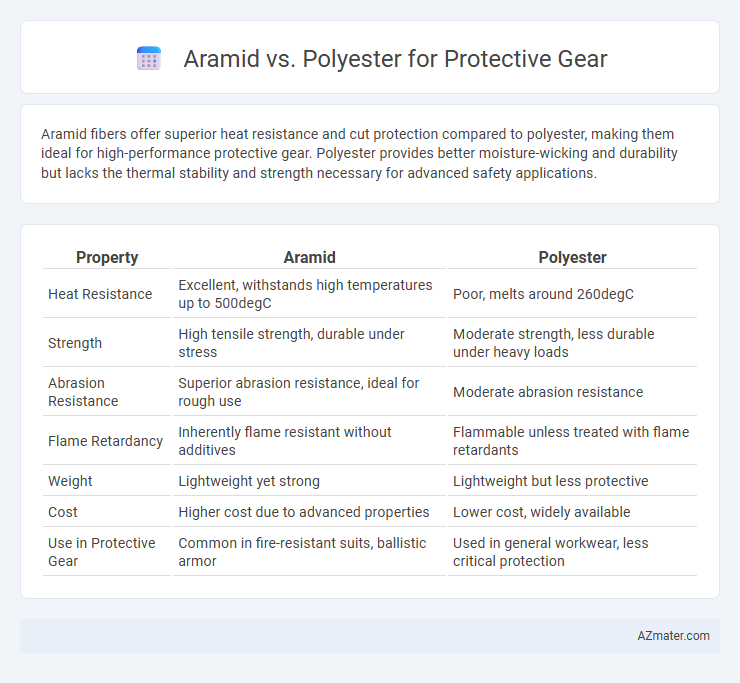Aramid fibers offer superior heat resistance and cut protection compared to polyester, making them ideal for high-performance protective gear. Polyester provides better moisture-wicking and durability but lacks the thermal stability and strength necessary for advanced safety applications.
Table of Comparison
| Property | Aramid | Polyester |
|---|---|---|
| Heat Resistance | Excellent, withstands high temperatures up to 500degC | Poor, melts around 260degC |
| Strength | High tensile strength, durable under stress | Moderate strength, less durable under heavy loads |
| Abrasion Resistance | Superior abrasion resistance, ideal for rough use | Moderate abrasion resistance |
| Flame Retardancy | Inherently flame resistant without additives | Flammable unless treated with flame retardants |
| Weight | Lightweight yet strong | Lightweight but less protective |
| Cost | Higher cost due to advanced properties | Lower cost, widely available |
| Use in Protective Gear | Common in fire-resistant suits, ballistic armor | Used in general workwear, less critical protection |
Introduction to Protective Gear Materials
Aramid fibers, known for their exceptional heat resistance and high tensile strength, are commonly used in protective gear for firefighters, military personnel, and industrial workers to provide superior cut and flame protection. Polyester, while less heat-resistant than aramid, offers excellent durability, abrasion resistance, and moisture-wicking properties, making it suitable for lighter-duty protective clothing and base layers. Selecting the appropriate material depends on the specific hazard environment, balancing weight, comfort, and protection levels to ensure optimal safety performance.
What is Aramid? Key Properties
Aramid fibers, such as Kevlar and Nomex, are synthetic polymers known for their exceptional strength-to-weight ratio and high thermal resistance, making them ideal for protective gear. These fibers exhibit excellent cut resistance, flame retardancy, and durability under extreme conditions, which surpasses many other materials like polyester. Aramid's ability to maintain integrity under heat and mechanical stress ensures superior protection in applications such as firefighting, military armor, and industrial safety equipment.
What is Polyester? Key Properties
Polyester is a synthetic polymer known for its durability, resistance to abrasion, and quick-drying properties, making it suitable for various protective gear applications. It offers excellent tensile strength and chemical resistance but lacks the inherent flame resistance found in aramid fibers. Polyester's lightweight nature and cost-effectiveness contribute to its widespread use in safety clothing, although it requires treatment or blending with other fibers to enhance protection against high heat and flames.
Strength and Durability Comparison
Aramid fibers, such as Kevlar, offer superior tensile strength and high thermal resistance, making them ideal for protective gear requiring maximum durability under extreme conditions. Polyester, while less strong, provides excellent elasticity, abrasion resistance, and UV stability, suitable for lighter protective applications. The inherent heat resistance and cut protection of aramids outperform polyester, ensuring longer-lasting performance in high-risk environments.
Heat and Flame Resistance
Aramid fibers, such as Kevlar and Nomex, offer superior heat and flame resistance compared to polyester, making them ideal for protective gear used in high-temperature environments. Aramid materials can withstand temperatures exceeding 500degC without melting or dripping, ensuring enhanced protection against burns and flames. Polyester fibers, while durable and affordable, typically begin to melt around 250degC, limiting their effectiveness in extreme heat or direct flame exposure.
Chemical and Abrasion Resistance
Aramid fibers, such as Kevlar and Nomex, exhibit superior chemical resistance against acids, alkalis, and solvents, making them highly suitable for protective gear in harsh chemical environments. Polyester fibers offer moderate chemical resistance but excel in abrasion resistance, providing durable protection against wear and tear. The combination of aramid's chemical stability and polyester's abrasion resistance often results in blended fabrics that optimize protective performance for industrial and firefighting applications.
Comfort and Breathability
Aramid fibers like Kevlar offer superior heat resistance and strength but tend to be less breathable and stiffer compared to polyester, impacting comfort during extended wear. Polyester provides enhanced moisture-wicking properties and better air circulation, promoting greater ventilation and reducing heat buildup in protective gear. Choosing between aramid and polyester often depends on the balance between required protection levels and wearer comfort in specific operational environments.
Cost and Availability
Aramid fibers, such as Kevlar, tend to be more expensive than polyester due to their advanced heat resistance and superior durability in protective gear applications. Polyester is widely available and cost-effective, making it a popular choice for budget-conscious protective equipment manufacturers. Despite higher costs, aramid's exceptional performance often justifies its use in high-risk environments where enhanced protection is critical.
Real-World Applications: Aramid vs Polyester
Aramid fibers, known for their exceptional heat resistance and high tensile strength, are widely used in firefighter suits and military ballistic armor, providing superior protection against flames and impacts. Polyester, while less heat-resistant, offers greater flexibility and cost-effectiveness, making it suitable for industrial workwear and sporting gear where moderate protection and comfort are prioritized. Real-world applications favor aramid for high-risk environments that demand robust thermal and mechanical defense, while polyester is chosen for lighter-duty protective clothing requiring durability and moisture resistance.
Choosing the Right Material for Protective Gear
Aramid fibers, such as Kevlar, offer superior heat resistance, high tensile strength, and excellent cut protection, making them ideal for firefighting, military, and industrial protective gear. Polyester provides durability and moisture resistance but lacks the thermal and cut-resistant properties essential for high-risk environments. Selecting the right protective material depends on specific hazards, with aramid favored for chemical, thermal, and mechanical threats, while polyester suits lighter-duty applications requiring flexibility and water resistance.

Infographic: Aramid vs Polyester for Protective Gear
 azmater.com
azmater.com